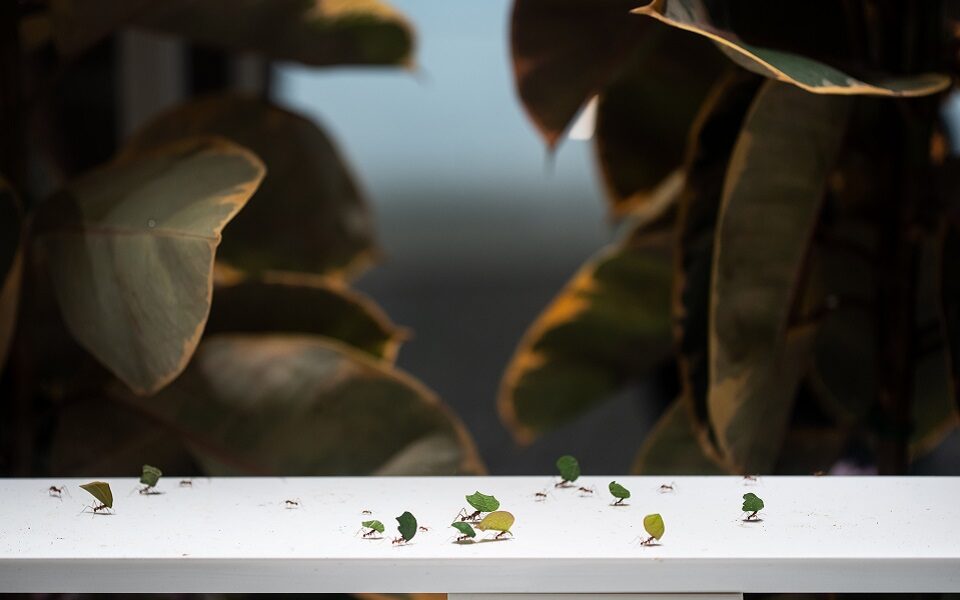Inside the scramble to make a half-million ants feel at home

When the American Museum of Natural History’s new insectarium opens on May 4, a half-million leafcutter ants will share the title of star attraction.
The ants are biological marvels, living in enormous colonies that function as a single superorganism. They are sophisticated farmers, collecting leaves that they use to nurture sprawling fungal gardens, which provide food for the colony.
Creating the new leafcutter exhibit was a six-year journey that took the museum’s team – and the ants – from a farm in Trinidad, where the tangerine-size colony was collected, to a lab in Oregon, where it grew large enough to fill a bathtub, and then on a six-day drive across the country in a U-Haul van.
And that wasn’t even the hard part. The ants, which moved into their museum habitat in January, were slow to adjust to their new home, failing to harvest enough leaves to sustain their fungal gardens.
“We’ve had a few ups and downs,” said Hazel Davies, the museum’s director of living exhibits. “Some problem-solving, as we expected, because it’s a pretty unique exhibit.”
Here’s how the museum eventually helped the ants find their way.
To put the ants’ agriculture on display, the museum designed a sprawling, open exhibit made from lab-tested, “ant-approved” materials, from braided stainless steel to old-fashioned Legos. “The ants got to pick a lot of stuff,” said Ryan Garrett, a self-described “ant wrangler” and founder of Leaf House Scientific who collected the ant colony and served as a consultant on the habitat.
The design had the ants tending to their fungal gardens in glass orbs and then traveling an ambitious route to collect their leaves, crossing a transparent skybridge upside-down and clambering over aluminum poles.
The team stocked the foraging area with blackberry bramble and filled the surrounding moat with water to help keep the ants contained.
Then, they loaded the ant-filled orbs, which had been temporarily plugged with balls of Play-Doh, into the exhibit. (A hand-held vacuum was deployed to collect ants that had ventured out of the orbs to forage, sucking the insects up into “a friendly tornado,” Garrett said.)
They unplugged the orbs and waited for the ants to find their way, a process they expected to take at least several days.
It took weeks. Some ants quickly made their way up to the skybridge and even down to the ant highway leading toward the foraging area, but there they seemed to stall. “We knew it was a big ask,” Davies said. “It’s like you heading downtown to look for groceries, but not being told where to go.”
The team needed just a small subset of ants to blaze the path; when the first ants returned from the foraging area, they would leave a pheromone trail that their sisters could follow. The museum began coaxing the ants forward by laying down a trail of apples and leaves.
But soon another problem emerged: The gallery, which was still under construction, was too dry for the tropical ants. So a humidifier was installed behind the exhibit, funneling moisture into the display case.
The ants’ path was simplified, a rope strung across the skybridge so the ants would no longer have to cross it upside-down. Another shortcut allowed the ants to bypass some of the aluminum poles.
By mid-April, lines of ants had begun parading leaves back to their orbs. “It felt like the ants were celebrating,” Garrett said.
There is more work to do. The ants have not really taken to the braided metal that seemed so promising in the lab, and they keep falling into the moat. Garrett recently fashioned a temporary “ant filter” from blackberry branches to help the insects climb out.
But the team has now removed the big shortcuts, nudging the ants along more challenging paths. Just days ago, the ants finally completed the entire route and even began winding their way across an elevated maze detour.
“I know everyone wanted the ants to easily walk straight to the foraging jungle, but I think this process of them slowly figuring out their way is really beautiful,” Garrett said. “Day by day we watch them learn.”
This article originally appeared in The New York Times.






